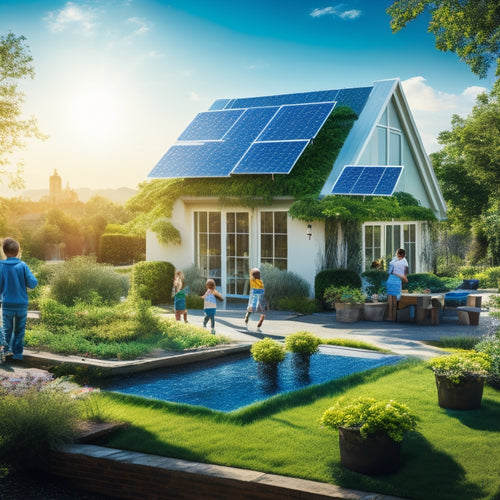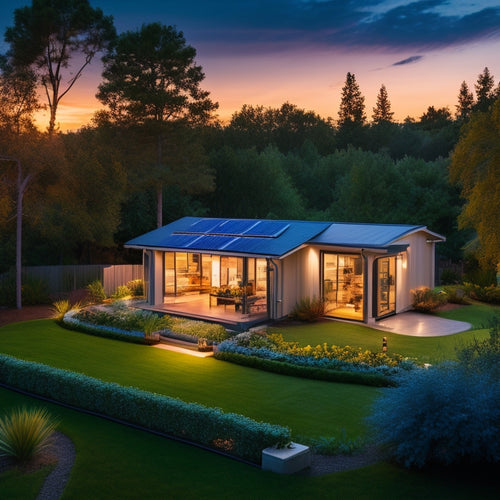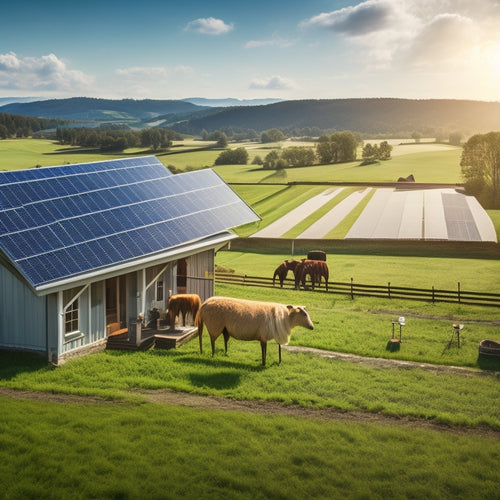
High-Efficiency Solar Cells for Home Installation
Share
You're investing in high-efficiency solar cells to maximize your home's energy independence and reap the benefits of cleaner, renewable power. These advanced cells, such as monocrystalline and thin-film, boast efficiency ratings up to 23%, converting more sunlight into electricity. Higher energy output means lower electricity bills, space maximization, and enhanced control over energy usage. When selecting panels, consider factors like energy output, durability, and warranty. Top brands like Panasonic, LG, and SunPower offer high-wattage panels that generate more power per hour of sunlight. As you investigate the world of high-efficiency solar cells, you'll uncover even more ways to optimize your home's energy production.
Key Takeaways
- High-efficiency solar cells, like monocrystalline and polycrystalline cells, achieve higher energy conversion rates, reducing reliance on traditional power sources.
- Choosing the right solar panel involves evaluating energy output, durability, and warranty, with top brands like Panasonic, LG, and SunPower offering high-performance options.
- Proper installation and maintenance are crucial, including site assessment, correct panel angle, regular cleaning, and seasonal adjustments to maximize energy generation.
- High-efficiency solar cells may come at a higher initial cost, but they provide faster returns on investment and long-term savings due to increased energy production.
- Future solar energy technology advancements, such as panel design innovations and energy storage solutions, will continue to improve efficiency, affordability, and accessibility for homeowners.
Understanding High-Efficiency Solar Cells
Most solar panels on the market today have an efficiency rating of around 15-20%, meaning they can convert only a fraction of the sun's energy into usable electricity.
As you consider installing solar panels for your home, it's crucial to understand the types of solar cells that can optimize energy conversion. High-efficiency solar cells are designed to maximize energy output, and they come in various types, including monocrystalline, polycrystalline, and thin-film solar cells.
Monocrystalline solar cells have the highest efficiency rating, with some models reaching up to 23%. These cells are made from a single crystal of silicon, allowing them to convert sunlight into electricity more efficiently.
Polycrystalline solar cells, on the other hand, are made from multiple crystals of silicon, making them less efficient but more affordable.
Thin-film solar cells use a thin layer of photovoltaic material to convert sunlight into electricity, making them the least efficient but most cost-effective option.
Benefits of High-Efficiency Solar
High-efficiency solar cells offer a multitude of benefits that can greatly impact your solar panel installation. By utilizing more energy from the sun, you'll reduce your reliance on traditional power sources, leading to significant energy savings.
This, in turn, will lower your electricity bills and minimize your environmental impact. With high-efficiency solar cells, you'll generate more power per unit area, allowing you to maximize your energy production even with limited roof space.
This increased energy output also enables you to power more appliances and devices, giving you greater control over your energy usage. Additionally, high-efficiency solar cells are often built with durable materials, ensuring a longer lifespan and reduced maintenance costs.
Choosing the Right Solar Panel
With high-efficiency solar cells offering a range of benefits, it's now important to select the right solar panel to maximize your energy savings and environmental impact. You'll want to evaluate factors like energy output, durability, and warranty when choosing a solar panel.
Here's a comparison of three top solar panel brands:
| Brand | Energy Output (Watts) |
|---|---|
| Panasonic | 330-370 |
| LG | 320-360 |
| SunPower | 380-420 |
When evaluating energy output, look for panels with higher wattage ratings, as they'll generate more power per hour of sunlight. Additionally, assess the temperature coefficient, which affects energy output in high-temperature conditions. A lower temperature coefficient means the panel will perform better in hot weather. By selecting a high-efficiency solar panel from a reputable brand, you'll be able to generate more power and reduce your carbon footprint.
Installation and Maintenance Tips
When installing high-efficiency solar cells, you'll need to conduct a thorough site assessment to identify potential obstacles and optimize panel placement.
It's vital to angle your panels correctly to maximize energy absorption, as even slight deviations can notably impact performance.
Regular cleaning is also essential to maintain peak efficiency, as dirt and debris can reduce energy output by up to 25%.
Site Assessment Required
You need to conduct a detailed site evaluation before installing high-efficiency solar cells to guarantee peak performance and longevity. This vital step helps identify potential obstacles that might hinder your system's energy production. A wide-ranging site evaluation includes judging the following factors:
| Factor | Description |
|---|---|
| Shading | Identify areas with partial or complete shading from trees, buildings, or other obstructions |
| Roof Size & Orientation | Determine the available roof space and its orientation (south-facing is ideal) |
| Energy Load | Calculate your energy requirements based on your home's energy consumption |
| Local Building Codes | Verify compliance with local building codes, permits, and regulations |
| Environmental Conditions | Consider local weather patterns, wind direction, and extreme weather events |
A detailed site evaluation enables you to optimize your solar panel installation, guaranteeing maximum energy production and a faster return on investment. It's important to work with a professional installer who can conduct a thorough energy evaluation to identify the best installation strategy for your specific site conditions.
Panel Angle Matters
Optimizing panel angle is crucial for maximizing energy output from high-efficiency solar cells, as it directly affects the amount of sunlight that hits the photovoltaic surface.
When installing your solar panel system, you'll want to guarantee the ideal tilt to capture the most sunlight. This typically ranges between 30 and 40 degrees, depending on your local climate and installation orientation.
Seasonal adjustments can also improve energy generation. During winter, when the sun is lower in the sky, a steeper tilt can help increase sunlight exposure. Conversely, a shallower tilt during summer can reduce shading effects.
Consider consulting with a professional to determine the best angle for your specific system.
Regular Cleaning Needed
High-efficiency solar cells require more than just an ideal panel angle to maximize energy output. You need to guarantee regular cleaning to maintain their performance. Dirt and debris can reduce energy output by up to 25%, so it's crucial to incorporate cleaning into your maintenance schedule.
| Weather Effects | Cleaning Frequency |
|---|---|
| Heavy rainfall or snowfall | Immediately after weather clears |
| Coastal or industrial areas | Every 2-3 months |
| Normal conditions | Every 6 months |
| Extreme pollution | Every 3-4 months |
| Desert or dry conditions | Every 4-6 months |
You can clean your solar panels yourself using a soft-bristled brush, mild soap, and distilled water. However, if you're not comfortable with heights or don't have the time, consider hiring a professional service. They'll use specialized equipment and cleaning methods to guarantee peak energy output. Regardless of the cleaning method, make certain to clean your panels during the early morning or late afternoon to avoid damaging them. By incorporating regular cleaning into your maintenance schedule, you'll guarantee your high-efficiency solar cells continue to provide maximum power output.
Cost and Efficiency Comparison
Breaking down the economics of high-efficiency solar cells reveals a complex interplay between cost and efficiency. As you evaluate the benefits of high-efficiency solar cells, it's vital to reflect on the cost analysis.
While these cells boast higher efficiency metrics, they often come at a higher upfront cost. For instance, high-efficiency cells can cost up to 20% more than their standard counterparts.
However, when you factor in the increased energy output, high-efficiency cells can provide a faster return on investment. With higher efficiency comes greater energy production per unit area, resulting in more power generated over the system's lifespan.
This increased energy output can lead to significant long-term savings on your electricity bills. When evaluating the cost-effectiveness of high-efficiency solar cells, it's important to weigh the initial investment against the long-term benefits.
Future of Solar Energy Technology
As you investigate the future of solar energy technology, you'll uncover advancements in panel design that prioritize efficiency and sustainability.
You'll also encounter innovations in green tech that reduce environmental impact while increasing energy output.
These developments will shape the industry's path, driving the widespread adoption of high-efficiency solar cells.
Solar Energy Advancements
The horizon of solar energy technology is expanding rapidly, driven by innovations that promise to alter the manner in which we harness the sun's power.
As you consider integrating solar energy into your home, it's crucial to understand the advancements that are shaping the industry.
You'll benefit from recent breakthroughs in:
-
Solar policy: Governments are implementing incentives and tax credits to encourage the adoption of solar energy, making it more accessible and affordable for homeowners like you.
-
Energy storage: Advances in battery technology have made it possible to store excess energy generated during the day for use during the night or on cloudy days, ensuring a reliable power supply.
-
Thin-film solar cells: These lightweight, flexible cells offer higher efficiency rates and lower production costs, making them an attractive option for residential installations.
- Smart inverters: These advanced inverters optimize energy output, monitor performance, and provide real-time data, enabling you to maximize your energy production and reduce waste.
These advancements have positioned solar energy as a viable, efficient, and cost-effective solution for homeowners seeking to reduce their reliance on traditional power sources.
Efficient Panel Design
Five innovative design elements are changing the terrain of solar panel efficiency, clearing the path for a future where solar energy becomes an increasingly viable option. You'll want to take into account these advancements when selecting a high-efficiency solar panel for your home installation.
Advanced panel materials, such as bifacial cells and thin-film technology, are enhancing efficiency metrics. Design innovations like multi-junction cells and tandem cells are also improving performance.
Thermal management techniques, like heat sinks and cooling systems, help maintain ideal operating temperatures, reducing energy losses.
Aesthetic considerations, such as sleek frames and slim profiles, make solar panels more appealing for residential installations. Efficient installation techniques, like tracker systems and optimized array layouts, further enhance energy harvest.
Rigorous performance testing guarantees that panels meet high standards for efficiency and durability. Scalability options, like modular designs, make it easier to expand or upgrade your system.
As market trends drive demand for high-efficiency solar panels, manufacturers are prioritizing durability factors, like weather resistance and extended warranties, to meet your long-term energy needs.
Green Tech Innovations
Beyond the current advancements in high-efficiency solar cells, researchers are pushing the boundaries of green tech innovations, ready to revolutionize the future of solar energy technology.
You're about to witness a change that will redefine the way you generate power at home.
As you investigate the latest breakthroughs, you'll uncover:
- Sustainable materials: Scientists are developing novel materials that reduce environmental impact while maintaining high energy conversion rates.
These eco-friendly materials will soon become the norm in solar cell production.
- Energy storage advancements: Researchers are working on more efficient energy storage solutions to guarantee a steady power supply, even when the sun isn't shining.
This means you'll have a reliable source of energy, 24/7.
-
Building-integrated photovoltaics: You'll soon be able to integrate solar panels seamlessly into your home's design, making them a stylish and functional addition to your property.
-
Artificial intelligence-driven monitoring: AI-powered monitoring systems will optimize energy production and detect potential issues before they arise, securing maximum energy output and minimal downtime.
These innovations will soon make high-efficiency solar cells an even more attractive option for your home installation.
Frequently Asked Questions
Can High-Efficiency Solar Cells Be Used for Commercial Properties?
You're wondering if high-efficiency solar cells can power commercial properties; yes, they can, but you'll need to weigh cost benefits against installation challenges, considering factors like roof size, energy demands, and local building codes.
Are High-Efficiency Solar Cells More Prone to Damage?
As you traverse the complex terrain of solar energy, you'll find that high-efficiency solar cells are not inherently more prone to damage, but their higher cost considerations and durability factors demand careful installation and maintenance to guarantee peak performance.
Do Solar Cells Lose Efficiency Over Time?
You'll find that solar cells naturally lose efficiency over time due to efficiency degradation, which is influenced by lifespan factors like temperature, humidity, and UV exposure, ultimately affecting their power output and overall performance.
Can I Install High-Efficiency Solar Cells Myself?
You can attempt a DIY installation, but be aware that installation challenges, like ensuring proper electrical connections and meeting safety regulations, may outweigh any cost comparison benefits, and may even void warranties.
Are High-Efficiency Solar Cells Compatible With Existing Systems?
Can you really afford to overlook compatibility issues? Fortunately, you'll find that high-efficiency solar cells are designed to integrate seamlessly with existing systems, thanks to advancements in solar technology, which won't break the bank, as installation costs are relatively low.
Conclusion
As you invest in high-efficiency solar cells for your home, remember that scientists predict a 26% increase in solar energy conversion rates by 2030. This means that today's high-efficiency solar cells will soon be outperformed, making it essential to evaluate upgrade options and future-proofing your installation. Stay ahead of the curve and reap the benefits of state-of-the-art solar technology, ready to transform the manner we utilize renewable energy.
Related Posts
-

Solar Energy Benefits for Sustainable Living
Solar energy provides numerous benefits for sustainable living that you can't overlook. By switching to solar, you'll...
-

Solar Power Backup Solutions During Outages
Solar power backup solutions guarantee you have reliable energy during outages, providing essential power when the gr...
-

Solar Power Systems for Rural Properties
Solar power systems offer a reliable and efficient energy solution for rural properties, allowing you to gain energy ...


